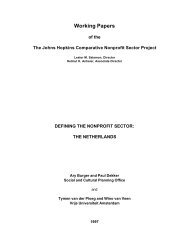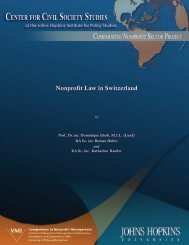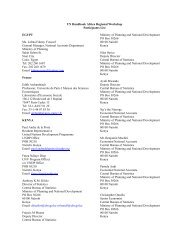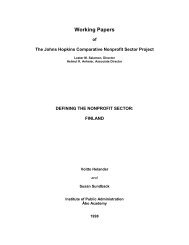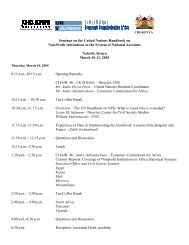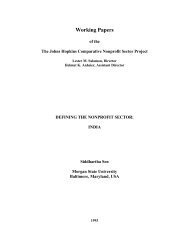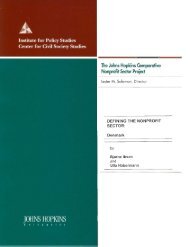Campetella, González Bombal, and Roitter<strong>Defining</strong> <strong>the</strong> <strong>Nonprofit</strong> <strong>Sector</strong>: <strong>Argentina</strong>social citizenship was developed; and that structural tendencies, which are now being modified, wereinaugurated in <strong>the</strong> economy, politics, and society.Considering <strong>the</strong> four models proposed by <strong>the</strong> social origins <strong>the</strong>ory, we believe that <strong>the</strong> mostappropriate for that period in Argentine history is <strong>the</strong> corporatist model, whose main hypo<strong>the</strong>sisposits a direct relationship between <strong>the</strong> state’s social spending and <strong>the</strong> dimension and scope of <strong>the</strong>nonprofit sector; that is, <strong>the</strong> higher social welfare spending, <strong>the</strong> bigger <strong>the</strong> nonprofit sector. In thisrelationship, <strong>the</strong> state makes common cause with nonprofit organizations, creating a state-sponsoredwelfare system that includes a substantial role for nonprofits. However, this conclusion is valid onlyas long as we understand corporativism in a slightly different sense. The social origins <strong>the</strong>oryassumes that nonprofit institutions function in <strong>the</strong> corporatist model as a “pre-modern” mechanismdeliberately preserved by <strong>the</strong> state in order to retain <strong>the</strong> support of traditional elites. However, <strong>the</strong>development of <strong>the</strong> welfare state in <strong>Argentina</strong> was based not on <strong>the</strong> permanence of “pre-modern”mechanisms but ra<strong>the</strong>r on <strong>the</strong> emergence of a new social coalition that displaced traditional elites.The coalition consisted of <strong>the</strong> state, small and medium-scale industries, and trade unions, andoperated within a political regime in which corporate pressure –as a form of interest representationand influence on public policies– was relatively higher than that of political parties.Fur<strong>the</strong>rmore, <strong>the</strong> common cause between <strong>the</strong> state and nonprofit organizations was not arelationship of cooperation in <strong>the</strong> strict sense of <strong>the</strong> word, which would suppose two different entitiesin collaboration with each o<strong>the</strong>r. Ra<strong>the</strong>r, in <strong>Argentina</strong>, <strong>the</strong> sphere of <strong>the</strong> state expanded by“incorporating” associations and inserting <strong>the</strong>m in relationships that blurred <strong>the</strong> borders of public andprivate. The clearest examples are <strong>the</strong> emergence of a national health care system based on obrassociales –which, in turn, originated from <strong>the</strong> mutual benefit associations created by immigrants–, and<strong>the</strong> role played by <strong>the</strong> trade union movement.In 1955, when Perón was overthrown by a coup d’etat, a long period of economic andpolitical instability began, characterized by extreme politicization and <strong>the</strong> generalization of politicalviolence. This period concluded with <strong>the</strong> bloody dictatorship established in 1976, which in turnended with <strong>the</strong> democratic transition initiated in 1983. From <strong>the</strong> perspective of <strong>the</strong> social origins<strong>the</strong>ory, it is difficult to comprehend this convulsive period and delve into its consequences. In thishighly politicized context, <strong>the</strong> political function performed by civil society organizations comes to<strong>the</strong> fore, and this function is not totally visible within <strong>the</strong> cited <strong>the</strong>ory.The re-establishment of democracy in <strong>the</strong> 1980s and <strong>the</strong> economic reforms of <strong>the</strong> 1990s havebrought a greater differentiation among <strong>the</strong> spheres of <strong>the</strong> market, <strong>the</strong> state and <strong>the</strong> civil society.This tendency seems to bring <strong>the</strong> Argentine case closer to <strong>the</strong> liberal model described by <strong>the</strong> socialorigins <strong>the</strong>ory. However, it is necessary to take into account that this is a historical moment markedby reforms and by <strong>the</strong> emergence of new development patterns. Hence, this transitional charactermust be taken into account by social scientists interested in <strong>the</strong> nonprofit sector.In principle, <strong>the</strong> model that seems to best describe <strong>the</strong> current period is <strong>the</strong> liberal model,which hypo<strong>the</strong>sizes that low social welfare spending corresponds to a large nonprofit sector.Economic stabilization under a free market economy, <strong>the</strong> consequent withdrawal of <strong>the</strong> state fromtraditional welfare functions, and <strong>the</strong> growing public visibility of nonprofit organizations are severaltendencies that support <strong>the</strong> idea of a transition towards a liberal model. Likewise, cooperative23
Campetella, González Bombal, and Roitter<strong>Defining</strong> <strong>the</strong> <strong>Nonprofit</strong> <strong>Sector</strong>: <strong>Argentina</strong>relationships between <strong>the</strong> state and <strong>the</strong> nonprofit sector are developing in <strong>the</strong> form of partnerships for<strong>the</strong> implementation of public policies.However, here again it is necessary to set out several particularities of <strong>the</strong> Argentine casewith respect to <strong>the</strong> liberal model. In <strong>the</strong> first place, <strong>the</strong> development and social visibility acquired by<strong>the</strong> nonprofit sector in <strong>the</strong> last decades was a result more of political reality than of its welfarefunction. After <strong>the</strong> last dictatorship and during <strong>the</strong> democratic transition, civil society organizationshave mushroomed, and <strong>the</strong> presence of <strong>the</strong> so-called NGOs –mainly linked to civil and humanrights– has initiated a civil dimension of citizenship –i.e., independent from political parties andpolitical identities– and enabled a greater autonomy of <strong>the</strong> civil society.In <strong>the</strong> second place, <strong>the</strong> liberal model assumes a significant ideological and political hostilityto <strong>the</strong> extension of state social welfare protections and a decided preference for voluntaryapproaches. In <strong>the</strong> case of <strong>Argentina</strong>, <strong>the</strong> political dimension comes again to <strong>the</strong> foreground, as <strong>the</strong>hostility towards <strong>the</strong> state was situated in <strong>the</strong> political sphere, due to <strong>the</strong> gross human rightsviolations perpetrated by <strong>the</strong> military dictatorship. The novelty brought about by NGOs –evidencedin <strong>the</strong> very term– was <strong>the</strong>ir position in opposition to <strong>the</strong> state, demanding justice and respect forhuman and civil rights, asking for transparency, and performing civil control over governmentalactions. On <strong>the</strong> contrary, <strong>the</strong> current withdrawal of <strong>the</strong> state from <strong>the</strong> welfare functions it hadperformed since <strong>the</strong> 1940s is not a result of ideological hostility but of <strong>the</strong> economic crisis and <strong>the</strong>structural reforms of <strong>the</strong> 1990s. In this respect, <strong>the</strong> responsibility of <strong>the</strong> state for <strong>the</strong> welfare of <strong>the</strong>population is still a highly appreciated value in <strong>Argentina</strong>, shared by public opinion and <strong>the</strong> majorityof civil society organizations.In <strong>the</strong> third place, <strong>the</strong> liberal model assumes a central role of <strong>the</strong> middle classes in <strong>the</strong>development of <strong>the</strong> nonprofit sector. However, <strong>the</strong> main hypo<strong>the</strong>sis of this model seems to besupported precisely at <strong>the</strong> point when <strong>the</strong> Argentine middle classes –comparatively, among <strong>the</strong>largest in Latin America– are undergoing a significant reduction, what has been referred to as <strong>the</strong>“new poverty phenomenon” (Minujin, 1992).In conclusion, we believe that <strong>the</strong> most appropriate decision from <strong>the</strong> perspective of <strong>the</strong>social origins <strong>the</strong>ory is to place <strong>the</strong> Argentine case –beginning in <strong>the</strong> 1940s– coming from acorporatist model and tending to a liberal one. However, we also believe that it is essential toinclude <strong>the</strong> political and change dimensions. This inclusion will allow us to understand <strong>the</strong>transformation of <strong>the</strong> nonprofit sector’s development, as well as <strong>the</strong> transformations in <strong>the</strong> pattern ofrelationships among <strong>the</strong> spheres of <strong>the</strong> market, <strong>the</strong> state, and <strong>the</strong> civil society.Conclusions<strong>Argentina</strong> is currently undergoing structural transformations that seem to indicate aprogressive autonomy among <strong>the</strong> spheres of <strong>the</strong> state, <strong>the</strong> market and <strong>the</strong> civil society, within <strong>the</strong>stable context of democratic institutions. These tendencies allow for a clearer vision of nonprofitorganizations as a sector with distinctive features and functions. Briefly, <strong>the</strong> third sector is currentlyappreciated from two different perspectives. A political perspective highlights <strong>the</strong> potential ofnonprofits to re-create cooperative and solidarity links and to create instances of civil participation in24
- Page 1 and 2: Working PapersofThe Johns Hopkins C
- Page 3 and 4: PREFACEThis is one in a series of W
- Page 5 and 6: Campetella, González Bombal, and R
- Page 7 and 8: Campetella, González Bombal, and R
- Page 9 and 10: Campetella, González Bombal, and R
- Page 11 and 12: Campetella, González Bombal, and R
- Page 13 and 14: Campetella, González Bombal, and R
- Page 15 and 16: Campetella, González Bombal, and R
- Page 17 and 18: Campetella, González Bombal, and R
- Page 19 and 20: Campetella, González Bombal, and R
- Page 21 and 22: Campetella, González Bombal, and R
- Page 23 and 24: Campetella, González Bombal, and R
- Page 25: Campetella, González Bombal, and R
- Page 29 and 30: Campetella, González Bombal, and R
- Page 31 and 32: Campetella, González Bombal, and R
- Page 33: Campetella, González Bombal, and R



